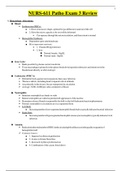Study guide
NURS 611/ NURS611/ NURSING 611/ NURSING611/ NUR611/ NUR 611: Patho Exam 3 STUDY GUIDE
- Institution
- Maryville University Of St. Louis
NURS-611 Patho Exam 3 Review ¾ Hematologic Alterations: Blood: Erythrocytes (RBCs): ■ 1. Have a biconcave shape, optimal for gas diffusion in and out of the cell ■ 2. Have the micro capacity to be reversibly deformed ● Can squeeze through the microcirculation, and then return to normal H...
[Show more]



